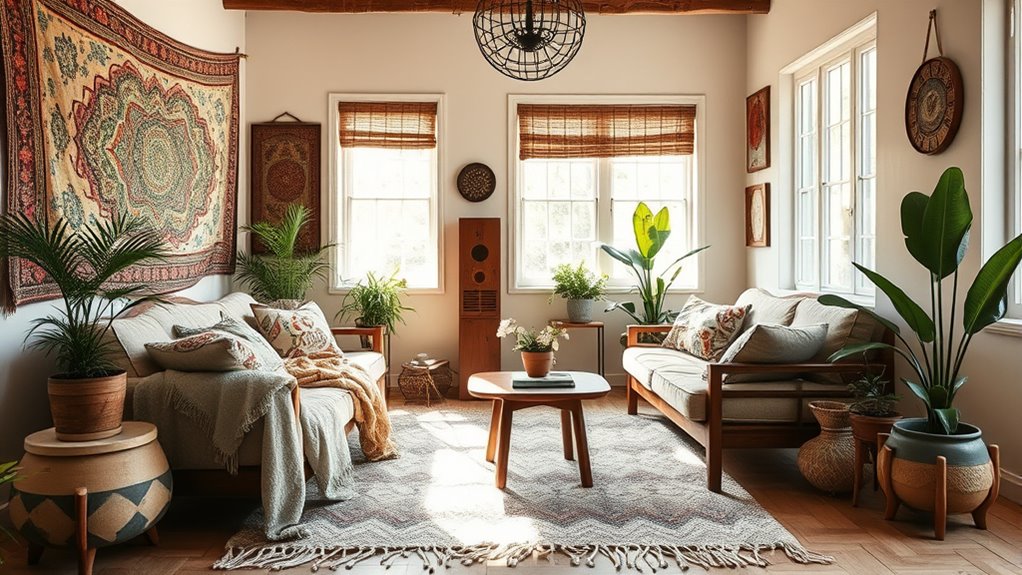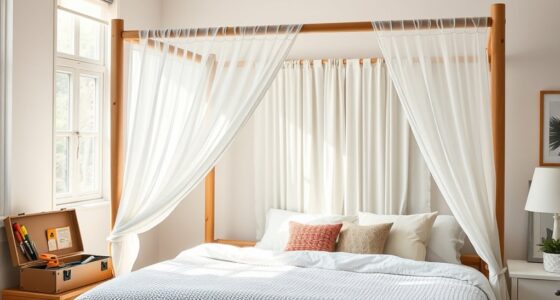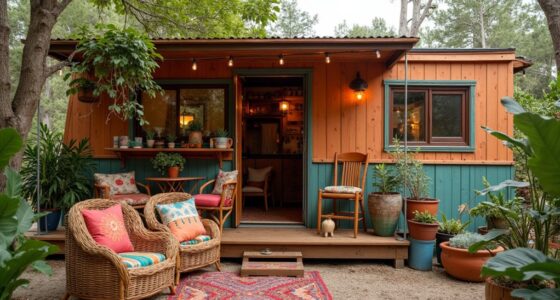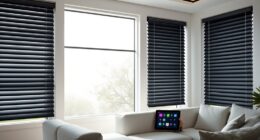To soundproof your boho space softly, incorporate textiles like woven rugs, plush cushions, and flowing curtains to absorb echoes and noise naturally. Add decorative panels such as macramé hangings and fabric-covered acoustic pieces for style and function, creating a cozy, layered look. Focus on natural fibers and strategic placement to maximize sound absorption without sacrificing aesthetics. Keep exploring for more ideas on blending style and sound comfort seamlessly in your space.
Key Takeaways
- Use textured textiles like rugs, throws, and curtains to absorb sound naturally while enhancing boho decor.
- Incorporate decorative panels such as macramé or fabric-covered acoustic panels for aesthetic sound absorption.
- Layer diverse textiles and panels strategically around the space to create a cozy, sound-dampening environment.
- Choose natural fibers like jute, linen, and cotton to combine style with effective noise reduction.
- Focus on thoughtful placement of textiles and panels to maximize soundproofing without compromising boho aesthetics.

If you’re looking to reduce noise without sacrificing comfort, soundproofing softly is an ideal approach. Embracing textiles and decorative panels allows you to create a cozy, boho-inspired space that muffles unwanted sounds while enhancing your decor. You don’t need heavy, industrial materials to make a difference; instead, carefully chosen fabric accents and stylish panels can do the trick. These options add personality to your room and serve a practical purpose, blending seamlessly with your aesthetic.
Start by incorporating fabric accents into your space. Soft, textured textiles like throw pillows, rugs, and curtains absorb sound waves naturally. Opt for materials with varied textures—think fringed throws, woven baskets, or plush cushions—to add visual interest and acoustic comfort. Layering different fabrics also helps break up sound waves, making your environment quieter and more intimate. You can choose earthy tones, vibrant boho patterns, or neutral shades, depending on your style. The key is to select textiles that feel inviting and complement your overall decor scheme.
Incorporate textured textiles like rugs, pillows, and curtains to naturally absorb sound and enhance your boho decor.
Decorative panels are another powerful tool in your soundproofing arsenal. These panels come in a variety of styles, from macramé wall hangings to fabric-covered acoustic panels. When you hang these decorative panels on your walls, they serve dual purposes: as art pieces and as sound absorbers. Look for panels made from natural fibers like jute, linen, or cotton, which are effective at dampening sound and align well with a boho aesthetic. Position them strategically around your space—above your seating area or near noisy sources—to maximize their impact. Not only do they reduce echo and noise, but they also add texture and depth to your walls, elevating your room’s visual appeal.
Another tip is to combine fabric accents with decorative panels for a layered, textured look. For example, hang a series of woven wall hangings alongside upholstered furniture and patterned rugs. This creates a cohesive, inviting environment that’s both stylish and functional. The key is to select pieces that resonate with your personal taste and comfort needs. You don’t have to cover every wall—just enough to make a noticeable difference in the room’s acoustics.
In essence, soundproofing softly with fabric accents and decorative panels lets you craft a serene boho retreat without sacrificing style. These elements are versatile, easy to integrate, and can be updated over time as your taste evolves. By focusing on natural textures and thoughtful placement, you’ll build a space that’s both beautiful and peaceful—a perfect haven for relaxation and connection. Incorporating sound absorption materials like textiles and panels can significantly improve your room’s acoustics while maintaining your aesthetic appeal.
Frequently Asked Questions
Are Textiles Effective for Blocking All Types of Noise?
No, textiles aren’t effective for blocking all types of noise. Fabric insulation and acoustic textiles can absorb sound waves, reducing echoes and muffling high-frequency sounds, but they struggle with low-frequency noises like bass or loud voices. To achieve better soundproofing, combine textiles with other methods like insulation panels or sealing gaps. This way, you create a cozy, boho space that minimizes unwanted noise without sacrificing style.
How Do I Choose the Best Soundproofing Panels for My Space?
To select the best soundproofing panels, consider your space’s style and noise levels. Look for decorative accents that complement your boho vibe and guarantee easy installation with clear tips like mounting options and placement tips. Opt for panels with high sound absorption qualities, and measure your area accurately. Prioritize panels that blend aesthetics with functionality, making your space both beautiful and quieter.
Can Soft Furnishings Improve Sound Quality, Not Just Noise Reduction?
Yes, soft furnishings can improve sound quality by enhancing acoustic balance, not just noise reduction. When you add decorative accents like plush cushions, rugs, and curtains, you create a more inviting atmosphere while absorbing echoes and reducing harsh sounds. These textiles and panels contribute to acoustic enhancement, making your space feel warmer and more comfortable. Incorporate a variety of soft furnishings to optimize sound quality and elevate your boho decor effortlessly.
What Maintenance Is Required for Textile Soundproofing Materials?
To maintain textile soundproofing materials, you should regularly clean the fabric to keep it looking fresh and effective. While gentle fabric cleaning prevents dust buildup and preserves textile durability, avoid harsh chemicals that could damage the fibers. Rotate or reposition panels periodically to prevent uneven wear. This simple upkeep enhances both the soundproofing performance and aesthetic appeal, ensuring your boho space stays cozy and functional for years to come.
Are Eco-Friendly Textiles Available for Soundproofing Purposes?
Yes, eco-friendly textiles are available for soundproofing. You can choose recycled fabrics and natural fibers like hemp, cotton, or wool, which effectively absorb sound while being sustainable. These materials not only reduce environmental impact but also add a cozy, boho vibe to your space. By selecting eco-friendly options, you’re making a conscious choice that benefits both your home’s acoustics and the planet.
Conclusion
Imagine stepping into a cozy boho sanctuary, where textiles and panels wrap you in a gentle hush. Soft fabrics dance with the light, while acoustic panels blend seamlessly into your space, muffling the outside world. With each carefully chosen piece, you craft a haven of tranquility—where sound softly fades, and serenity blooms. Embrace these textiles and panels, and let your space become a peaceful retreat, whispering calm with every quiet moment.








